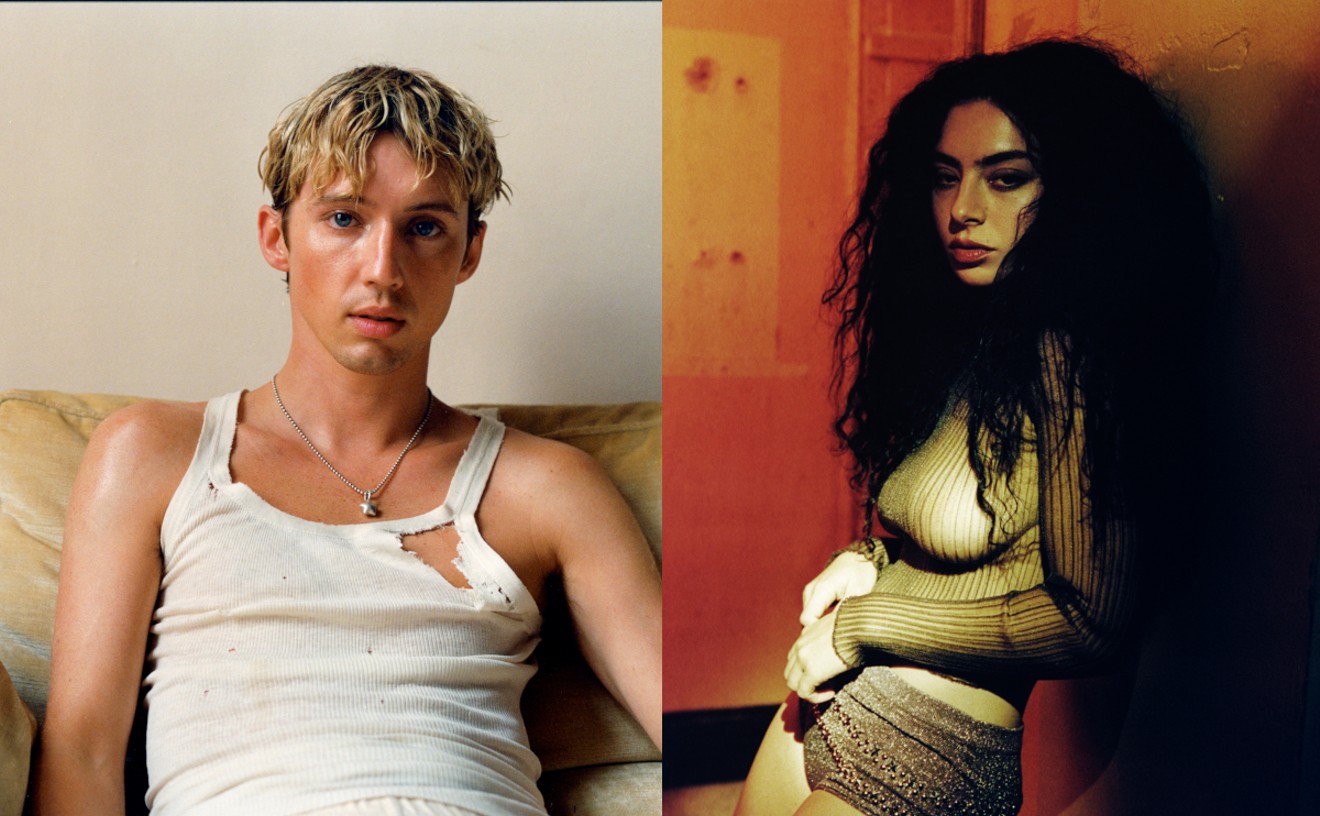Bubbles plows a big blue bucket along the border of his enclosure, tracing an invisible line. His fleshy feet thud against the concrete path. "He's just letting us know he's here," one of his caretakers says. Bubbles is behind a steel-wire fence with the rest of the apes. "He's big," she adds, "but he's a sweetie." The 4.5-foot-tall, 185-pound chimpanzee is built like a high school wrestling coach, with a gray beard and a small bald spot just above his brow. Keepers have called him ugly, but he doesn't care. He's come a long way since hanging on Michael Jackson's hip. Bubbles' moonwalking days are over. He's an alpha male now, and he marks his territory with that big, blue bucket.
A chimp named Oopsie looks down from a high platform. In the 1970s, she starred in the TV show B.J. and the Bear but now spends her days as the group's matriarch, grooming her babies and keeping the others well-behaved. Bubbles' best friend, Ripley, trails right behind him, egging him on. Ripley once spat water on Kramer in an episode of Seinfeld. Now he paints for charity and follows his buddy around like a brother. Forty other chimpanzees and orangutans have retired here. In their past lives, they've acted alongside Clint Eastwood, Jim Carrey, and Kevin Smith. They've made kids giggle in roadside circuses and photocopied their own butts in Super Bowl commercials. Once semicelebrities, these apes now reside well away from the media, in a private sanctuary in southern Central Florida.
"He was very shy for about a year or two. He'd often just sit in a corner."
tweet this
When Patti Ragan first thought of the sanctuary, she had a young orangutan and chimpanzee in her foster care and nowhere for them to go. It was the early '90s. There were just a few accredited ape sanctuaries in the United States, and zoos wouldn't take in certain apes because they prioritized pure bloodlines. So the 30-something sold her Miami-based temp agency and founded the nonprofit Center for Great Apes in Miami in 1993.
Ragan knew that most entertainment apes are infants and juveniles, pulled from their mothers at a young age. She read claims that some were beaten into submission to perform. An adolescent chimp is a strong and stubborn animal. An adult chimp is an unwieldy beast. Trainers tend to retire chimps at 8 years old, but since captives can live until age 60, some working chimps spend their 50 years of retirement in cramped cages. After captivity, they can't be assimilated into the wild. In the wilderness, you don’t get treats for tricks.
Great apes need lots of space and stimulation, so Ragan imagined a little jungle in Florida — an isolated woodland away from development — where her apes could act apish. In 1997, she found that jungle in a 15-acre, subtropical paradise in the small agricultural town of Wauchula, Florida. It was an island of oaks in a sea of orange groves and pastureland. Today, the Center for Great Apes is bordered by dense brush and deer fence, and it's expanded to include more than 100 acres of orange groves. There’s no sign out front, only a buzzer and a security gate.
"This property was perfect for us," Ragan says. She navigates a winding path, over a bridge and creek, under palms and banana trees. It's all remarkably well-maintained. Ragan lives at the sanctuary, near the entrance, so this is one of her regular routes. At night, she sleeps to the sound of the orangutans' droning calls from the 12 domed enclosures around the property.
Each of the three- to four-story structures houses a group of chimps or orangutans, separated and socialized to suit their character. Ropes, logs, and hammocks give the apes places to relax and play during the day. More than a mile and a half of elevated tunnels stretch out from each enclosure, twist through the woods, and connect the structures in a web, so you can sometimes see apes exploring in the trees.
An orangutan named Tango relaxes in the chute above us as we pass under. She used to do judo in the Tang drink commercials before starring in Jay and Silent Bob Strike Back. "Never stop under a causeway," Ragan says smiling as a stream of urine descends from the sky.
If Bubbles were a human, he would've had a pretty nice life, drinking tea and touring with Jackson. But Bubbles' life was not glamorous. Born in a biomedical research laboratory, he was pried from his mother's arms at just a few months old and eventually ended up as the King of Pop's favorite pet. He was an easy target from the moment he appeared alongside Jackson in 1986, a symbol of the celebrity's eccentricity. The media loved to mock their antics and matching outfits. The National Enquirer ran a story once claiming the singer Prince used ESP to drive the ape insane.
Bubbles never did go crazy, but he did grow up. By 2003, he was too aggressive for the Jackson family, so they sent him to live with an animal trainer before the Center for Great Apes rescued him in 2005. Here, he was mostly forgotten by the public.
Then Jackson died suddenly in 2009, and the media wanted to know how Bubbles took the news. "We didn't tell him," Ragan says. "They'd ask if Bubbles could go to Jackson's memorial, and I'd tell them how many hundreds of thousands of dollars it would cost." No one offered the money — not that Ragan would have sent him anyway — so as a reported 2.5 billion people watched Jackson's memorial, Bubbles groomed his friend Sam.
"It wouldn't make sense to him," Ragan explains about communicating "death" to a great ape. Some apes at the center can understand English, but abstract concepts are impossible to convey. "We could tell him," she says, "but he wouldn't get it." One of the center's caretakers did eventually show Bubbles a video of the memorial. Did Bubbles seem sad? "No," Ragan says.
There's an ape blowing raspberries from behind the fence while Ragan speaks. "They learn that from each other," she says. Old habits die hard for these apes. Back in their entertainment days, an on-cue kiss or raspberry meant a reward. Now they mean very little.
Bubbles' aversion to cameras is perhaps the most interesting vestige of his captivity. On his best behavior, the big chimp may turn his back or move out of the shot. At his worst, he's liable to spit water or chuck sand at the camera in protest.
This is at least one reason why Ragan was so disappointed by Anderson Cooper's producers when they came to film Bubbles shortly after Jackson's death. Despite countless requests, Ragan only let a few media into the center that year.
Cooper's film crew wanted footage of Bubbles, so Ragan and her staff comforted the chimp as the crew got close to the enclosure and filmed him through the fence. "They got some great footage of Bubbles playing with other chimps, splashing in the water, and running around the enclosure," Ragan says. But instead of footage of his habitat, CNN aired a short clip of Bubbles climbing through the chute. "Of course, people don't want to see apes behind caging," Ragan adds, "but our enclosures are really big." A "Free Bubbles" website formed shortly after. Ragan eventually calmed Bubbles' self-proclaimed emancipators, but she still refers to the episode as an irritation and an example of why publicity can be a blessing and a bane.
The center is closed to the public, so there's no income from visitor fees to fund it. It costs $20,000 annually per ape. Asked about the rumor that Jackson left some of his estate to Bubbles, Ragan says, "Not that I've seen." Few celebrities who've worked alongside the apes ever contact or offer to sponsor their costars' retirement. Instead, the center relies on memberships, donations, and charity events to raise money.
Bubbles is squatting calmly in his enclosure. "Hey, Bubbie, where's Ripley?" Ragan asks as she approaches. Bubbles doesn't respond.
Despite his current standing as a dominant male, Bubbles wasn't always sure of himself. His captive upbringing stunted his social skills, so he was voluntarily withdrawn when he arrived at the center in 2005. “He was very shy for about a year or two,” Ragan says. "He’d often just sit in a corner.”
Bubbles arrived with Sam, a "great, big, wonderful" chimp 14 years his senior. "Sam and Bubbles spent all their time together," she says, "but Bubbles was always nervous around the girls."
He eventually opened up, but as Sam's health deteriorated, Bubbles began to lose a vital friend and mentor. In 2009, a younger chimp named Ripley was introduced to the group. "They connected right away," Ragan says. When Sam suffered heart failure in 2011, Bubbles and Ripley consoled each other.
"Where's Ripley?" Ragan asks Bubbles again. She must not see Ripley hanging from the fence, his opposable digits laced through the wire. For an animal with such an unpleasant past, Ripley's gaze is peaceful. After starring in Ace Ventura and appearing in Seinfeld, Ripley was shipped to a small zoo in Nebraska with his brother and two other chimps. One day, he and his buddies escaped. When they were finally tracked down, Ripley's three companions were shot and killed. A frantic Ripley evaded his captors, ran back to his cage, and closed himself in.
Since arriving at the center, Ripley has taken to painting to express himself. In 2013, he won third place in the Humane Society’s 2013 Chimpanzee Art Contest.
"Ripley actually has more chimp experience," Ragan says. "He knows how to mediate, how to make up after fights. The other chimps respect Bubbles because he's such a big boy, but when anyone gets into a squabble, it's Ripley who goes around hugging everyone."
Bubbles has fans from Germany to Japan who sometimes send him gifts. A blanket with Jackson's face on it arrived from a devoted fan a few years ago. Bubbles cuddled it like any other blanket. He loves backpacks with Velcro, though. And he's a sucker for attention.
But there's very little of the red-overalls-wearing infant recognizable in him today. Like Jackson, Bubbles was thrust into celebrity before adolescence. His unusual childhood made him who he is today. But unlike Jackson, Bubbles' later life looks promising and protected from the public's judgment and prying eyes. He may, finally, have peace. At least, if Ragan and her staff have their say.
Donate to the Center for Great Apes or adopt an ape via centerforgreatapes.org.










